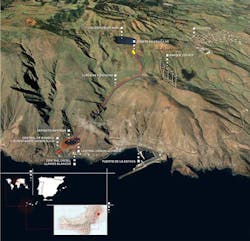Making much headway with renewable energy sources in highly populated areas with lots of existing utility infrastructure is proving to be no easy undertaking. From the issues of high equipment cost to the highly variable consumer demand for power, renewables are not yet a viable alternative in most cases. Regardless, we all realize the need for continued development of renewable energy to bring down equipment costs and raise the levels of power deliverable by these new — and needed — sources of energy. These issues must be addressed before we get to the point of having to rely on renewables as our primary energy sources.
The $87 million renewable energy project designed to eliminate the island’s need for imported power consists of an 11.5 megawatt (MW) wind farm and an 11.3 MW hydroelectric pumped storage plant that will provide the island’s inhabitants with 80 percent of their energy needs. Solar thermal collectors and grid-connected photovoltaic systems will generate the remaining 20 percent.
Elecnor, the project’s engineering, procurement and construction (EPC) contractor, is using power and control systems from ABB to electrify and control the hydroelectric pumped storage plant as well as to integrate energy generated by wind and hydropower turbines into the island’s power grid.
Controlled by an ABB distributed control system (DCS) that is based on ABB’s System 800xA extended automation platform, the DCS will control the island’s four hydropower turbines, pumped storage process, a new interconnection substation and existing substation. The DCS will also handle communications with the new wind farm.
By communicating with the wind farm, the ABB control solution will automatically start releasing water from the upper reservoir to generate power at the hydroelectric plant whenever the wind power generated is insufficient to meet demand. Conversely, excess wind power will be used to pump water to the upper reservoir, for use when wind power is low.
At the two pumping stations, the implementation of ABB motors, variable speed drives and dry-type transformers is designed to power the pumps at high levels of reliability while consuming minimal levels of energy and reducing equipment wear and tear.
About the Author
David Greenfield, editor in chief
Editor in Chief

Leaders relevant to this article:
